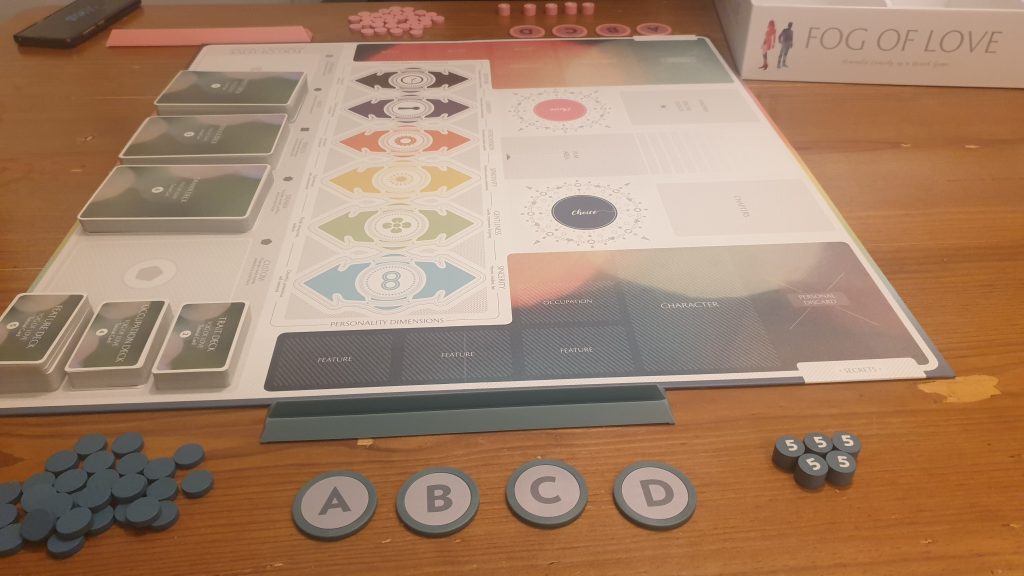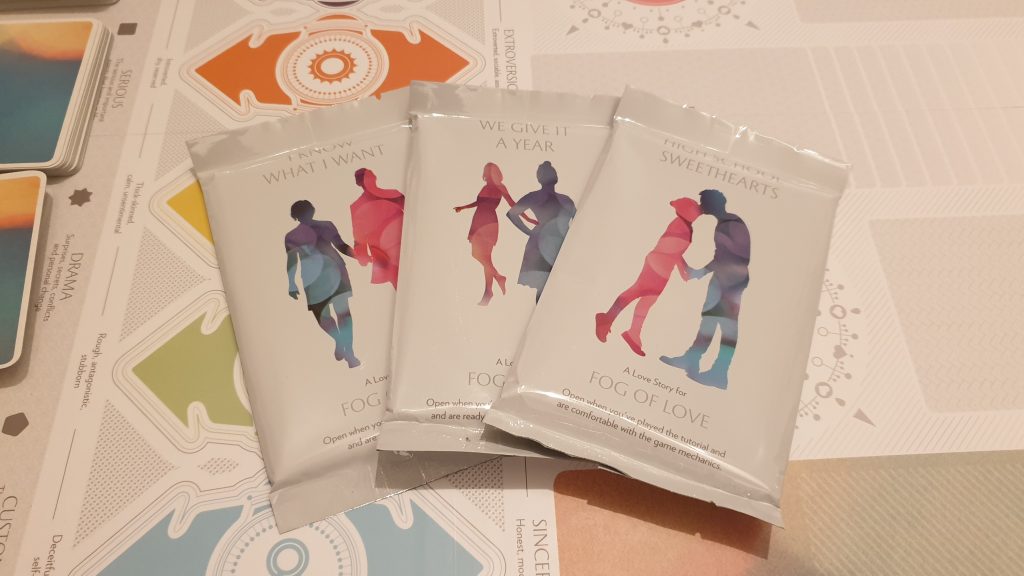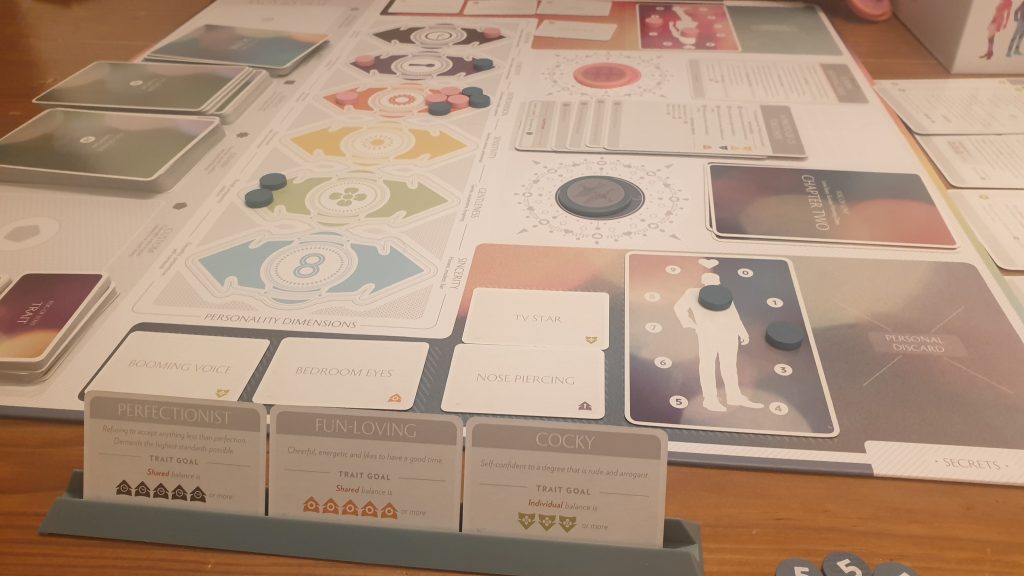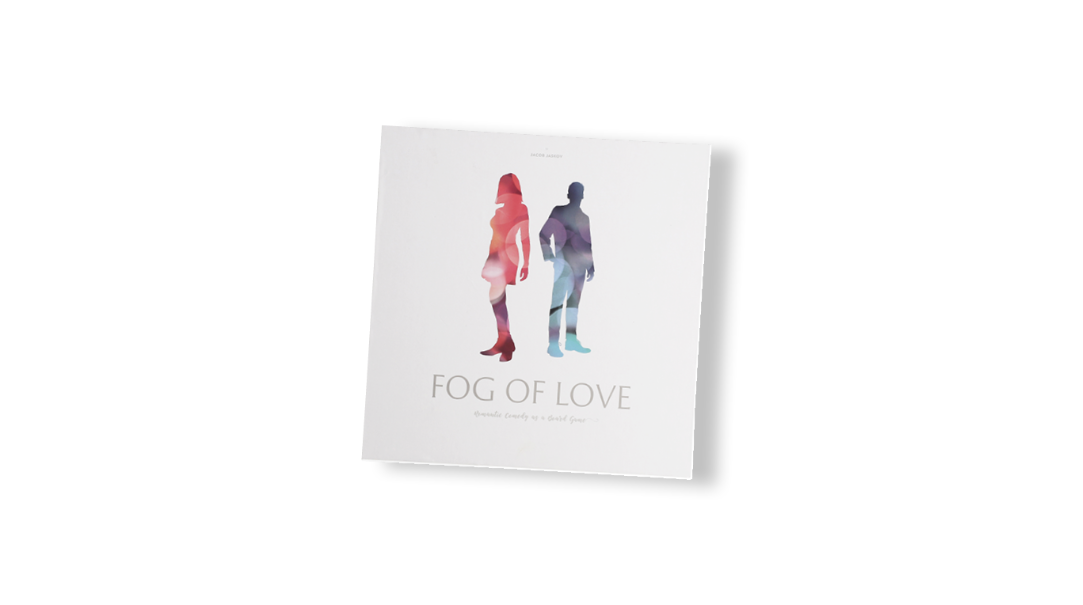Fog of Love is a cooperative role play board game, released back in 2017 by Hush Hush Projects. Designed by Jacob Jaskov, the game sees 2 players take up the roles of two individuals in a romantic relationship. Through storytelling and simulation players will experience the relationship, with scenes changing the course of the couple’s journey. However, is there enough of a game in the middle of the story? Let’s find out!
Aside from shuffling the separate decks of cards, and choosing a story to playthrough, the setup is almost part of the game. Akin to how players in D&D create a character, this occurs at the beginning of Fog of Love. The decisions form part of the journey and shape the characters the players become. Players will choose their characters gender, profession and traits. In an interesting twist players do not pick their features – instead their partner does. Once this is done the characters are complete and are ready to start the story.
Over the course of an hour or two players take it in turns playing scene cards from their hand. These commonly come in three levels, sweet, serious and drama. As the names suggest the scenes that come from these decks become less light-hearted, yet they all impact the story players create. Regardless of the deck, scene cards can come in different types. Some may be unrevealed secrets, others reactions to something your partner has done. The majority though offer choices. They present a scenario, for example a trip to IKEA. These then present a choice to both players or just your partner – with happiness and personality dimension points awarded accordingly.

Based upon their trait goals, players are aiming to pile tokens onto different ends of the personality dimensions (characteristics). For example, these characteristics could suggest players selected a sensitive or extroverted option. Some trait goals are individual, which are easier to influence. Some are shared with the character only happy (completing the trait goal) if as a couple they have a characteristic. Making matters harder, it is entirely possible that you and your partner are aiming for opposing trait goals.
Each story is split up into multiple chapters, each having a scene limit. Play continues back and forth until this limit is reached. At this point the next chapter card, which comes with a choice, is unveiled. Players are given much of the creative freedom, though at some point the story wraps itself up. Most card types will build towards these scene limits, getting the end closer. Secrets and minor scenes however do not count – just adding more narrative to the story.
Destiny cards are special objectives to see if your character is truly happy with the relationship. On top of trait goals, these are things your character will not feel complete without. Ranging from being unconditionally in love through to being the dominant one in the relationship each character you play can go for a different destiny. These are occasionally discarded or swapped, with only one held at the end of the game. For the most part these destiny cards keep the couple together, with players “winning” if they fulfill the requirements listed. Fog of Love isn’t entirely about winning or losing, it is much more about the journey players have taken the characters on.

The tutorial eases players into the experience. Card types, symbols and types of options are then carefully explained on the overview cards. By not presenting a rules barrier players are able to start enjoying the game instantly, before slowly picking up the rules through playing. There were one or two times where finding the specific card, for a rule clarification, was awkward – mostly due to the quantity. Nevertheless, having such a streamlined entry to play is one aspect I wish other games would look to emulate.
Fog of Love is open to plenty of player creativity and role play. With a use of Tells – where players must come up with options or answers – there are specific points at which the game encourages players. This isn’t to the extent that players are entirely forced. If you would feel uncomfortable when coming up with something on the spot often there is text to point you in a direction.
The start of the game, where each player chooses their opponents features, is a great way to start an unusual story off. Sometimes funny, sometimes serious these cards help the players break the ice between the two characters instantly. This can help those unsure of the role playing aspect to come out of their shell. It’s also an interesting twist from standard character creation, where neither player has total control over the formation of their own character.

The range of each card type is impressive at the beginning and this only increases as players open up the 3 included storylines – with special and new additions. To use the same example as above, as to not ruin additional cards, the trip to IKEA can be entertaining multiple times. It is also far from guaranteed to come up in every game. In addition, chances are players will pick very different options a second or third time seeing the scene. There is then an extra element of slight reminiscing on previous choices when this occurs. It doesn’t occur enough to be immersion breaking and repetitive. I cannot say that more variety wouldn’t be welcome but it doesn’t feel lacking.
Three stories and the tutorial, Sunday Morning Date, may not sound like ample amounts of content. Each of these come with chapters that are more of a wire framework of the story though. The scene cards, which are mostly pulled from the shuffled decks, fill in the majority of the story. This means those same few frameworks can result in polar opposite stories. Including the dividers in the base box for the expansion content may be a little bit of a cheeky nudge to buy more content. Thankfully, there is plenty in the base box for a solid number of hours entertainment. Even flying through one story will last an hour and they aren’t to be played through once.
Fog of Love manages to take players that normally dislike being put on the spot and lets them enjoy the experience. Each choice is open enough to allow creative people to unleash their imagination. At the same time there are some rails there for those less comfortable to hold onto and let the story unfold. If you were to play Fog of Love as if you were going through the motions of the actions on the surface it may look lacking. Gameplay-wise it is effectively choosing a card to play and an A-D option. Nevertheless, let yourself get even slightly immersed, taking on the role of your character, and it can be a unique and thoroughly enjoyable experience.
[Editor’s Note: Fog of Love was provided to us by Asmodee for review purposes. The game is currently available from local board game stores, find your local store here.]

